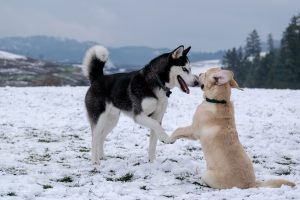Dog-to-dog aggression & dominance is a common behavior present in all canines, male dogs specifically being more inclined to demonstrate it. Involvement in such behaviors between unknown pooches can cause hostile confrontations and should be closely monitored. The presence of a new animal in a home with existing dogs can cause exacerbated reactions, yet certain occasions will develop easily if both animals are placid. In other cases, however, providing direction and assuming a leading role will assure that both canines understand the appropriate demeanor expected. Dog socialization and training are essential components of their education; for these reasons, never bring two untested dogs together unsupervised. Rather, have a reliable person present who will calmly and gently help them become acquainted. When you meet for the first time, don’t let them stand facing each other. Instead, keep them on a leash and take a walk together. The duration of this walk should be approximately 10 minutes to keep the two individuals separated while they get familiar with one another. Using the leash, don’t forget to let them properly meet; if one tries to dominate or lunge, bring them back in line and back onto the walk. Keep their contact minimal – but still, let them know each other. Jerking away is not advised. Keep both dogs on their leash as you take the next step forward. Reinforce and reward good behavior whenever it happens, to encourage them to continue feeling comfortable being around each other. After a little time has passed, this progress will be evident.

The anal glands of dogs produce a distinct aroma that can be used as a sort of identifying “fingerprint.” When canine friends take the scent of each other’s anal glands, they can decipher countless pieces of information. What’s more, they can use the smell to identify one another in the future. After letting the dog at the back sniff the one at the front, reinforce them with a reward such as a treat or another form of positive reinforcement. Then ask them to stay put. If two dogs are to get along, they can’t be leashed together constantly. If either has tried to dominate the other during their meeting, restrain them so they know it won’t be tolerated. Once they can be together and act appropriately, don’t tug on the leash too hard, simply use it to keep them in check. If you let your pets off their leash and allow them to interact, make sure to stay alert and constantly monitor them. If any fights erupt, take immediate action by putting the leash on until they calm down. While this method can help ensure a smooth first introduction, there are additional things to keep in mind when introducing your dog to puppies and adult dogs. Reference must be given to the different behavior taught for each circumstance. Puppies are currently transitioning and expanding their understanding of the world around them. During this period, socialization is particularly important for pet development. On the other hand, adult dogs tend to already have established characteristics and behaviors. Individual training is essential before introducing a dog to other dogs. We first need to understand and recognize the specific needs of each canine before proceeding. Canine education is essential to the growth and development of your furry friend; they should be taught the fundamentals prior to making acquaintances with other canines. Such a preparation process will ensure that your pooch has a smooth transition into meeting other dogs for the first time. Training methods such as “sit”, “heel” and “stay” are extremely helpful whenever introducing your pup to another dog. These basic commands will not only aid in better controlling the canines during their first meeting but also give you the chance to maintain proper composure over both pets. Introduce the two dogs on “neutral ground”; this will ensure they are both comfortable and not feel that one of them has an advantage in their territory. By meeting in this type of environment they can start to get to know each other better, as spending a lot of time together is required. If the first meeting between the two dogs doesn’t go as planned, it’s best to take them away from each other and focus on reinforcing their individual training. Doing so may help to make the transition smoother and bring the canines closer together in a friendly manner. If they are still struggling to coexist peacefully and are showing aggressive or dominating behaviors, then they should try again. Further attempts can be made to ensure that there is harmony between them.
 wagwagtail "only love can make your dog wag her tail"
wagwagtail "only love can make your dog wag her tail"
